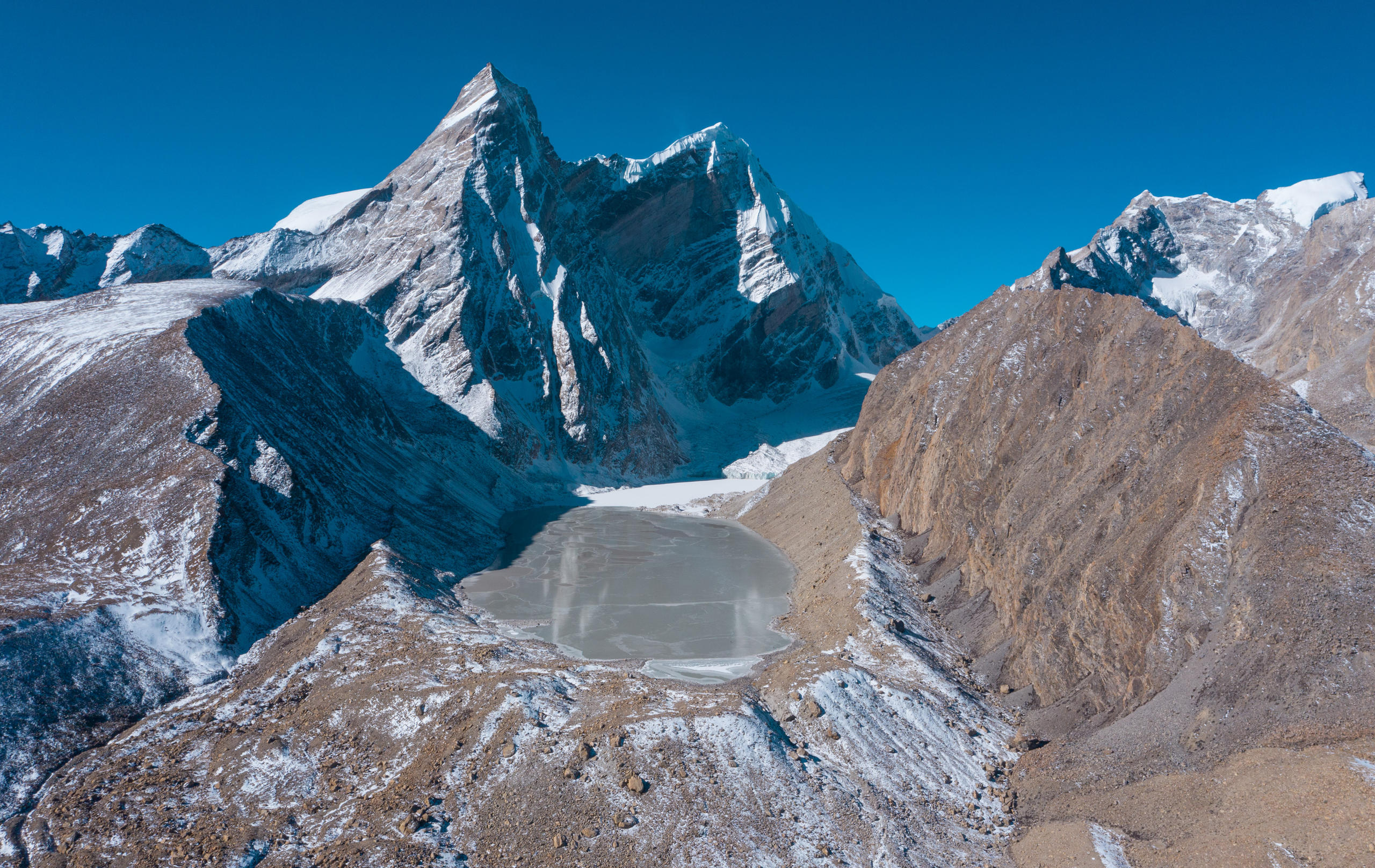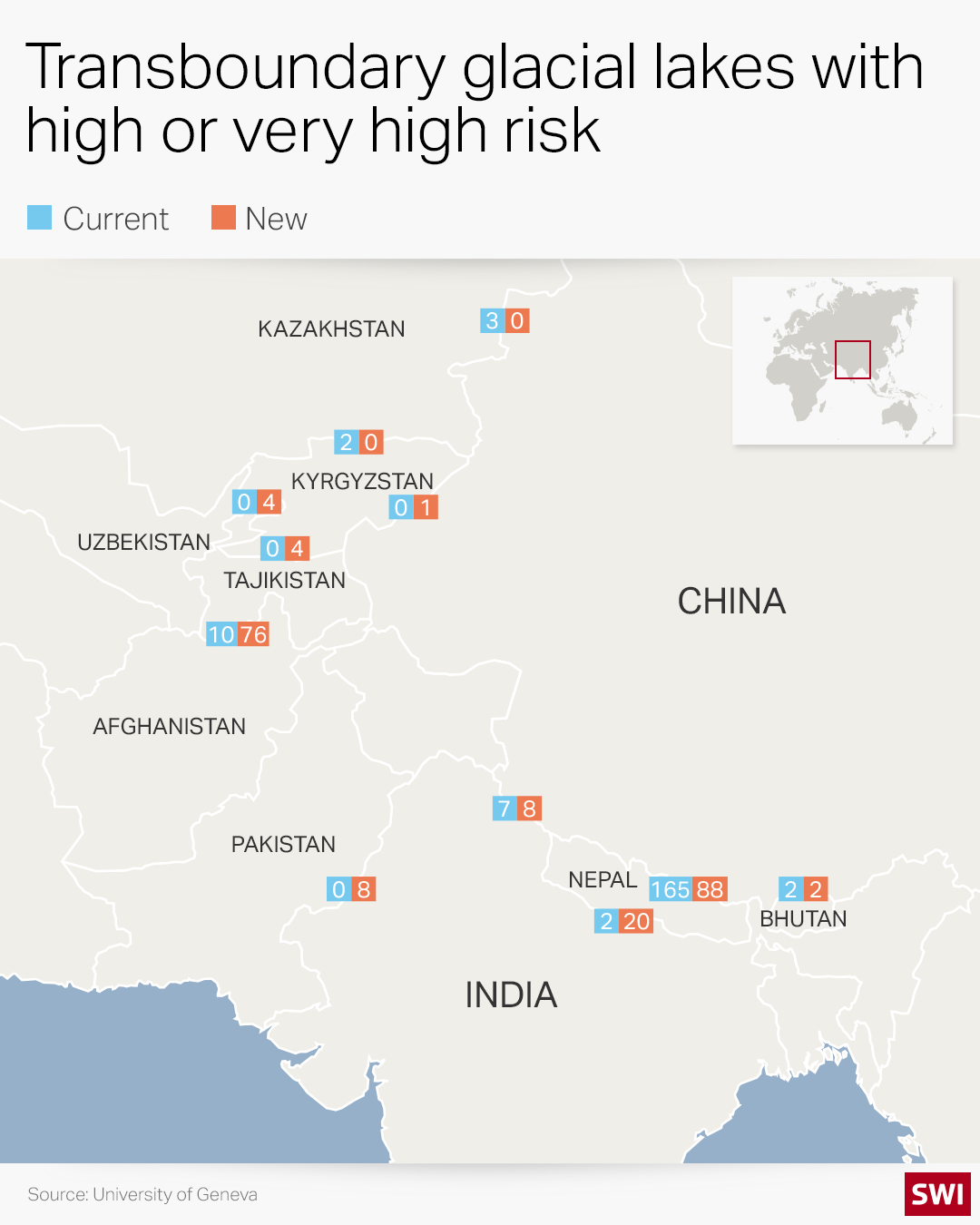
Himalayan nations can no longer ignore an environmental time bomb

Vulnerable Himalayan border regions are facing an increasing risk of glacial lake outburst flooding. The Swiss approach is part of their strategy to deal with an uncertain future.
Five years ago, a natural disaster struck the Chinese Himalayas: the Gongbatongshaco glacial lake in the Tibetan region burst its banks on July 5, 2016, sending huge volumes of glacial water down the mountain. The avalanche of water crossed the border into neighbouring Nepal, destroying the Bhotekoshi hydropower plant and flooding the China-Nepal highway.
The inhabitants of this border region were not informed by either the Chinese or Nepali authorities of the impending danger. Luckily nobody was killed but the damage was estimated at $70 million (CHF71.4 million at the time).
Growing problem
A recent study out of the University of Geneva published in the journal Nature Climate ChangeExternal link estimates that there are around 7,000 such glacial lakes in the Himalayas of which one in six pose a high or very high risk to downstream communities. Of these, 191 are in border areas and the China-Nepal frontier accounts for over 85% of them. The 2016 Gongbatongshaco flood was a wakeup call and kickstarted cooperation across borders.
“A Chinese research team commissioned by the Nepalese water and electricity department worked with Nepalese scientists to conduct a detailed survey and analysis of the event,” Chinese researcher Guoxiong Zheng, one of the authors of the University of Geneva study, told SWI swissinfo.ch.
But given that there are currently 165 high-risk glacial lakes along the two countries’ border, there is a clear need for more high-level cooperation. The Swiss Agency for Development and Cooperation (SDC) is currently working with the International Centre for Integrated Mountain Development (ICIMOD) based in Kathmandu on promoting Sino-Nepalese collaboration.
“Currently, we are in a preparatory phase where ICIMOD is conducting technical clarifications with Chinese and Nepalese partners on where the greatest transboundary GLOF risks exist in the Koshi Basin and how they can be addressed with an early warning system,” says Léa Zürcher, spokesperson for the Federal Department of Foreign Affairs.

Environmental diplomacy
Western Himalayan neighbours Afghanistan and Tajikistan, whose border has been identified as the new major transboundary hotspot for GLOFs, provides a good example of how China and Nepal’s relationship could develop. The Afghan-Tajik border region currently accounts for only 5% of the high-risk transboundary glacial lakes but its share is expected to increase to as much as 36% in the future.
Cooperation between the two countries also began as a result of a problematic high-altitude lake. Lake Sarez – not a glacial lake but formed after an earthquake – had in the past been labelled as the world’s worst natural disaster in the making. A collapse of the lake dam could affect as many as many as five million people in Tajikistan but also in Afghanistan, Uzbekistan and Turkmenistan, some estimates claim.
As a result of global media scrutiny, Tajikistan has been nudged by the international community (including Switzerland) to strengthen ties on cross-border environmental issues. The Geneva-based Zoi Environment Network has played an important role in facilitating this.
“There was nothing there before except a general agreement that they need to do something. We try to build bridges of cooperation between the two countries through meetings, joint expeditions and discussions on technical details and equipment,” says Zoi’s Central Asia expert Viktor Novikov.
Tajikistan and Afghanistan have signed three cross-border environment agreements so far: on hydrology, disaster management and environment protection.
“Water can be politicised of course, for example irrigation-related cooperation in central Asia can be difficult in terms of information exchange,” says Novikov. “But if it is a more generic water-related issue or risk then politics is kept out and everybody understands that it’s in the common interest to exchange information.”
Swiss expertise
Once countries are ready to cooperate on minimising the risks posed by GLOFs it is time to find specific technical solutions that are tailor-made to the region. This is where Switzerland’s expertise on the subject may be valuable. The Alpine nation has adopted an integrated risk management strategy for its own glacial lakes, in place since several decades. It involves a combination of early warning systems using sensors, partial emptying of the lakes when needed and building dams in the valley to retain the debris from such floods. But even wealthy Switzerland has not been able to afford implementing all these measures in all of its 120 glacial lakes.
Evolution of the Lower Grindelwald Glacier Lake between March and September 2008
Instead, experts do a risk assessment by identifying the hazards and estimating what could happen further down in the valley through modelling. They then try to estimate the costs that the disaster would create.
“By combining the two, and taking the lifespan of the intervention into account, you know if it is a good investment or a poor one,” says Markus Stoffel, a researcher at the University of Geneva. “They really weigh the economic cost of the measures against the economic loss or human loss.”
Himalayas-specific solutions
According to Stoffel the situation in the Himalayas is several magnitudes more precarious than Switzerland’s. There are thousands of glacial lakes in the region compared to a little over a hundred in Switzerland and most are in inaccessible regions or in areas where access is restricted by the military as they are in sensitive border zones. In addition, the valley slopes are much steeper in the Himalayas and there is a monsoon season with heavy rainfall that also exacerbates the risk of GLOFs.
One measure Himalayan countries can take is rethink how they build infrastructure like dams, highways, and bridges in regions with high risk of GLOFs. According to Stoffel, engineers building infrastructure in these countries often design them with a risk of a “once-in-a-century” catastrophic flood (also known as a 100-year return period) as a reference. The worst that they can cope with is therefore a heavy monsoon flood.
“But if you have these glacial lake outbursts the resulting floods will be much, much bigger than a monsoon flood caused by heavy rainfall,” Stoffel points out. “Depending on the site it could be a 200 year or 500 year or a 1000-year return period and the problem is that infrastructure high up in the mountains is normally not designed for these rare events.”
Stoffel also recommends that Himalayan countries invest in the cheaper option of setting up an early warning system to detect glacial lake flooding as soon as it occurs very high up in the catchment.
“It would then still give local residents further down in the valley a couple of minutes or maybe even tens of minutes to leave their villages and low-lying areas to get to safer ground. So, while they would not be able to prevent the worst damage to houses and settlements, they could at least save human lives,” he says.
This is already underway in the Tajikistan-Afghanistan border areas, with the technology in place. It now needs to be optimised and calibrated to local conditions and needs, according to Novikov.
Overcoming tensions
But what happens if neighbours have frosty relations with each other? India and China – the two biggest Himalayan nations – have been involved in recent military skirmishes along their border. Can they be expected to cooperate on glacial lake flooding under such circumstances? One solution is to focus more on technical cooperation and automate as much of the data collection and exchange as possible, Novikov says.
“If relations sour or fall to a low point, data exchange can stop due to mistrust. So the less of a human factor is involved, the lower the likelihood that information exchange is influenced by overall politics.”

In compliance with the JTI standards
More: SWI swissinfo.ch certified by the Journalism Trust Initiative





























Join the conversation!